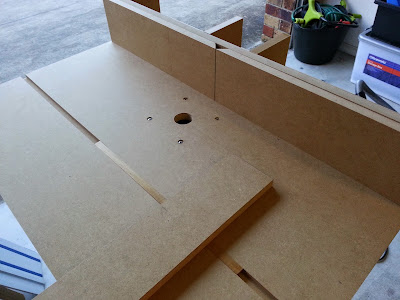Wheeled Cabinet with storage
My sister and I had some days off at the same time and she volunteered to help me get started on the cabinet for the router table. We began by roughing out the design on some scrap paper. The plan was to have a big drawer at the bottom to store all of my power hand tools and tool cases. The top drawer would be a lot shallower and used for smaller tools and accessories. Most of this stuff was cluttering my workbench and the floor, so I was keen to get them stored away neatly.
We used 18 mm MDF for the sides and drawer fronts and 16 mm MDF for pretty much everything else. I had bought some 12 mm particle board to make my tool wall, so we used that for the base. It didn't need to be strong, it just had to provide some additional rigidity.
We cut everything out using the Scheppach track saw and cut rebates for the base and top bracing using the router table itself.
Some glue and a whole bunch of screws later, I had a cabinet. I added two 70 mm locking swivel castors at the front and two fixed castors at the back. As you can see, I managed to put it to use right away.

Keeping the dust out
The project stayed this way for a few weeks. Once I got my new table saw *gasp* I decided that making some drawers for the cabinet would be a good first project.
The drawers are a basic construction. The sides are attached to the front and back using butt joints, glue and screws. The 12 mm particle board bases were rebated, glued and nailed. I bought some heavy duty full extension slides to make it easy to access items in the back. The 18 mm MDF fronts were then glued and screwed into place with as little clearance as possible to keep dust out. This video by John Heisz really helped with understanding how to install the slides.
The drawers are a basic construction. The sides are attached to the front and back using butt joints, glue and screws. The 12 mm particle board bases were rebated, glued and nailed. I bought some heavy duty full extension slides to make it easy to access items in the back. The 18 mm MDF fronts were then glued and screwed into place with as little clearance as possible to keep dust out. This video by John Heisz really helped with understanding how to install the slides.
Tidying up the switch
Once the drawers were done, all that was needed to make the table functional again was to feed the female end of the switch through the table so that I could connect it to the router. I started by cutting a hole big enough for the connector.
I then chiselled out a ramp to provide enough clearance to feed the cord behind the plastic body of the switch.

The switch was then screwed back onto the router table, hiding the hole and keeping everything looking neat and tidy. The dangling cord is the male end to be connected to mains.
Finishing touches
I made some pulls based on something I saw John John Heisz make, and enclosed underneath the hole in the router table with a 30mm deep box to keep the dust out of the top drawer but provide enough clearance to lower the router full depth through the hold made previously. I used a technique I saw in one of Marius Hornberger's videos to make this box using simple 45 degree glued mitre joints for all edges since it didn't have to be very strong.
How does it perform?
For my current needs, it's good enough. Adjustment of the router height is fiddly as you have to open the top, rest it on something (like your forehead) and fiddle with the Makita's "fine adjustment" ring until you get things right. Fence adjustment generally involves clamping it down then tapping with a hammer to "micro" adjust the positioning.Future improvements I plan to make include:
- Painting the cabinet to seal the MDF (which is easily affected by moisture)
- Dust collection
- Better adjustment mechanism for the fence
- Throwing it all away, buy a new router, and make something else that has a router lift :)

In the meantime, the table has been useful for more than just routing. It is my go-to flat surface for glue ups (my main work bench is usually too cluttered) and it is a good height for a table saw outfeed table when cutting large pieces. The castors make it super easy to move around my tiny space and the storage as well has been very useful as I try to adapt my single car garage into a functional workshop.



























